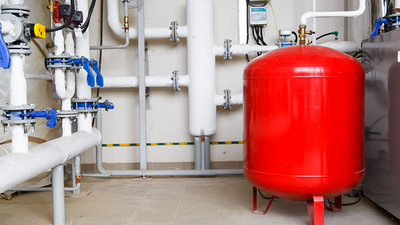Leak proof homes part 4: Expansion vessels

With the world increasingly focused on efficiency and the need to meet carbon reduction goals, it’s important to make sure existing systems are as efficient as possible. An often overlooked and misunderstood component, the expansion vessel is a crucial step to ensuring the performance and reliability of any unvented heating system. In our latest Leak Proof Plumbing blog, we look at best practice for sizing and fitting expansion vessels. You can read our previous blog in this series on leak proofing homes here.
Why are expansion vessels important?
Expansion vessels play a very important role in the safety and reliability of any unvented or pressurised heating system. Put simply, its purpose is to maintain the right level of pressure while the water heats and cools. Without one, the system can become dangerous.
The molecules in water expand as they heat, taking up more room than cold water. If left unchecked, the pressure in the system can rise to dangerous levels. To overcome this issue, combi-boilers are fitted with expansion vessels – a small container or tank which is divided in two by a rubber membrane. One side of the tank contains water, the other contains air or nitrogen. As the temperature in the system rises, expansion occurs. This expansion is slowly taken up by the expansion vessel membrane – and will drain back into the system pipework as the temperature and pressure lower again or if a tap is opened, relieving the pressure when fitted to an unvented hot water system.
Why is correct sizing critical?
Often completely overlooked or simply fitted with a like for like replacement during routine maintenance, correct sizing of an expansion vessel is critical. Failing to do so could impact the system’s performance and the life expectancy of the vessel itself. Insufficient thermal expansion protection could result in a leak or blowout causing potential damage to property.
The size of the expansion vessel required is dependent on the volume of water within the boiler, the number of radiators in use, the associated pipework as well as the pressure of the system when cold. An undersized vessel can result in high pressure in the system, creating wastewater as well as potentially triggering the safety relief valve. However, if the tank is the right size, the increase in pressure won’t cause the pressure relief valve to open, even when it reaches maximum temperature.

It’s where you put it that counts
Boilers are often supplied with expansion vessels that are designed to fit within the boiler housing. However, any extra demand on the system can mean that it isn’t large enough to cope.
When fitting an additional external expansion tank, the installation should be made at the coolest point. Doing so will avoid prolonged exposure to heat, which can damage the rubber membrane resulting in reduced life of the vessel and/or reduced elasticity, all of which will prevent the expansion tank from absorbing a rise in pressure.
Meeting regulatory requirements and best practice
The installation of unvented systems is subject to the legal requirements of Building Regulation G3. As well as stating that they must be installed by a ‘competent person’ who holds the relevant qualification, the guidelines require that hot water systems, expansion vessels and storage tanks are “fit for purpose”, preventing the temperature of the water stored in the vessel to exceed 100°C allowing it to discharge safely.
When selecting the right product for the job, look out for industry certifications. Reliance Valve’s Aquasystem potable cold water pressure vessels are manufactured to comply with UK water regulations and are tested and certified by WRAS – a seal of Government approval by a set of standards.
Aquasystem heating pressure vessels contain a butyl rubber membrane, which is a material especially resistant to higher temperatures. These pressure vessels are replaceable and separate the water and air, preventing contamination of the water system, corrosion of the pressure vessel, or loss of pressure.
Retrofit applications
Our Easifit® sealed kit uses a multibloc system, which is designed to make the initial installation process or conversion of a conventional vented heating system to a sealed one as easy as possible.
The Easifit Sealed System Expansion Vessel Kits include an expansion vessel with an integrated bracket system, a WRAS approved filling loop with blanking caps, an easy to read pressure gauge and a one-piece connection manifold that requires no assembly, reducing installation time and simplifying the process.

Service regularly
Regular servicing of expansion tanks should be carried out and the pressure checked every twelve months. Having the incorrect air pressure in the vessel can lead to leaks, damage and wear to components. The life of an expansion tank depends on the system operating temperature, pressure and oxygen content. Tanks can fail when a leak forms in the membrane, causing them to become waterlogged and ineffective. Ensuring the vessel maintains its pre-charge air pressure will extend the vessels lifetime, by preventing the membrane from over expansion, warping and eventually splitting.
Lack of expansion leads to unnecessary wear on the pump and other components, often reaching critical pressures and causing lasting damage. Not only does triggering the safety valves result in a waste of water and potential property damage, but it can also mean unnecessary call outs.
For assistance with sizing expansion vessels correctly and maximising system efficiency, our technical teams are on hand to help. You can get in touch with us here.
Discover our range
Robust expansion vessels that prevent excessive pressure building up in heating and cold water systems.
